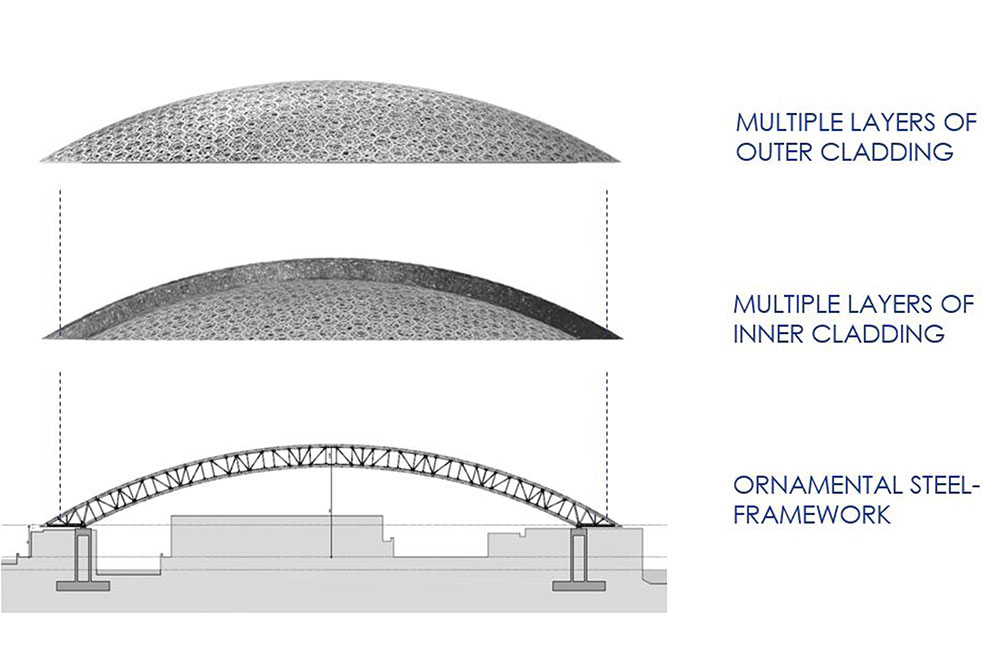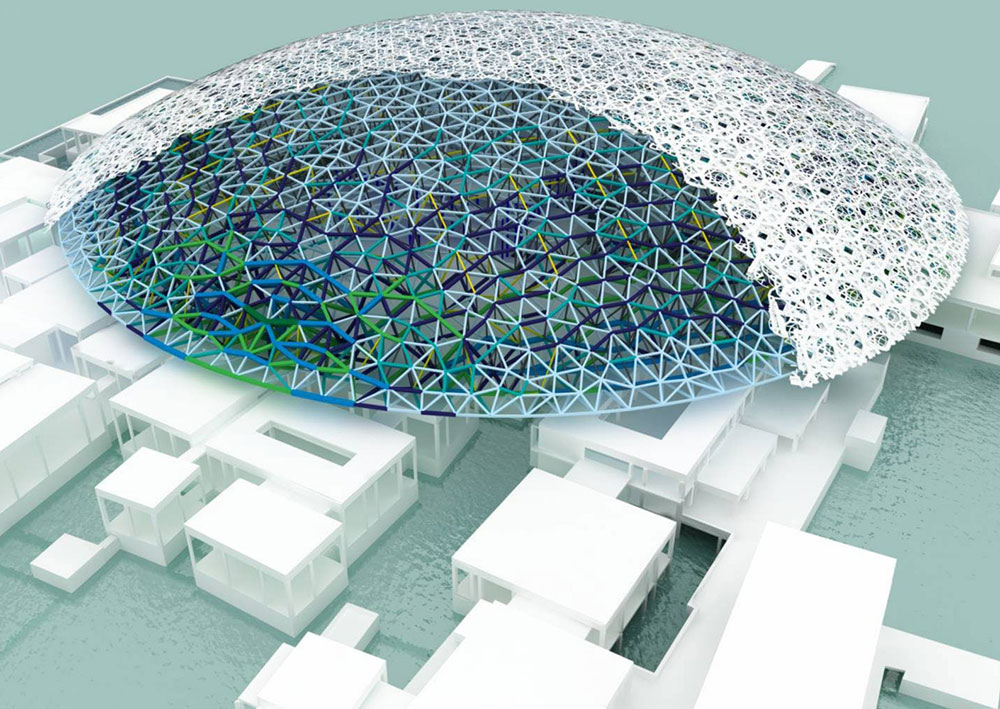Managing light
The interior exhibition spaces, comprising museum galleries, temporary exhibition spaces and Children’s Museum, make up 8,600 square metres, with permanent galleries covering approximately 6,400 square metres. Natural light filters through into all the museum galleries, either from lateral windows with views onto the surrounding environment or through the 17 glass ceilings within the museum galleries. This involves the use of glass mirrors to capture sunlight and direct it into the gallery spaces while also scattering rays to avoid glare. Each is made up of 18 different types of glass panels. The engineers modelled the path of the sun over 365 days. Then, using BIM technology, they developed the dome’s complex, multi-layered design to allow the sun’s rays to permeate the galleries without harming the works of art. One of the key challenges for BuroHappold was to ensure sunlight would never fall on the artworks. To achieve precise levels of light in rooms that have a combination of natural and artificial light, BuroHappold’s New York office produced a series of reports that predicted the sun’s path and anticipated daylight levels for each gallery. The reports even took into account the sensitivity of specific artworks to light.
All windows and rooflights incorporate three blinds – two to diffuse daylight and a third to act as a blackout blind. These operate automatically, based on a schedule produced by the modelling, combined with the output of light sensors giving real-time data. If light levels get too high, the blackout blinds prevent the possibility of damage to the artworks.

The glass ceilings incorporate both natural and artificial lighting to provide an optimal lighting system for the artworks on display. The Louvre,Abu Dhabi.
© Photography by Marc Domage. Architecture by Jean Nouvel. Engineering by BuroHappold
To meet stringent environmental control requirements within the museum galleries, the design team were asked not to deviate by more than one degree from 21 degrees centigrade or 5% humidity range. This guarantees exceptionally stable environmental conditions for artworks and visitors. Each gallery has dedicated run and standby air handling units (AHUs) concealed in the 10m deep, double-height basement, an arrangement that improves security and allows the plant to be maintained without engineers having to access the galleries.

The eight screens of steel and aluminium are supported by a steel superstructure. The Louvre, Abu Dhabi. Architecture by Jean Nouvel. Engineering by BuroHappold
A forest of steel
The dome is made up of eight different layers: the four outer layers are clad in stainless steel to reflect the sunlight whereas the four inner layers clad in aluminium to reduce the bearing load. A five meters high supporting steel frame structure was built first between the upper and lower layers. This frame is made up of 10,000 structural components that were pre-assembled into 85 super-sized elements, each weighing on average 50 tonnes.

The “forest of steel” within the domed roof of the Louvre, Abu Dhabi. Architecture by Jean Nouvel. Engineering by BuroHappold. Steel construction by Waagner Biro.
The load-bearing steel structure remains visible through the braided roofing. Jean Nouvel wanted this steel superstructure to remain visible. Moreover, most of the connectors are bolted together to emphasize the fact that this is a “mechanical construction”. Only the highly stressed profiles in the ring beam and in the vicinity of the bearings or node connection are welded. The dome is supported by four permanent piers, each 110 metres apart, hidden within the museum buildings to give the impression that the dome is floating. The interior dome elevation is 29 metres from the ground floor to the underside of the cladding. The highest point of the dome is 40 metres above sea level and 36 metres above ground floor level.

Cutaway showing roof design by BuroHappold. The Louvre, Abu Dhabi. Architecture by Jean Nouvel. Engineering by BuroHappold.
Project information
Client: Tourism Development & Investment Company (TDIC).
Architect: Ateliers Jean Nouvel (AJN); Hala Wardé (HW architecture), partner architect; Engineering: Arup (sketches); BuroHappold
Gross floor area: 97 000 m2
Contractors: Joint venture Arabtec Construction LLC/San Jose SA/Oger Abu Dhabi LLC